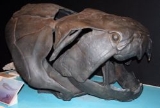
Dunkleosteus
Overview
Genus
In biology, a genus is a low-level taxonomic rank used in the biological classification of living and fossil organisms, which is an example of definition by genus and differentia...
of prehistoric fish
Prehistoric fish
Prehistoric fish refers to early fish that are known only from fossil records. They are the earliest known vertebrates, and include the first and extinct fish that lived through the Cambrian to the Tertiary. The study of prehistoric fish is called paleoichthyology...
, one of the largest arthrodire placoderms ever to have lived, existing during the Late Devonian period, about 380-360 million years ago.
This hunter, measuring up to 10 metres (32.8 ft) and weighing 3.6 tonnes (4 ST), was a hypercarnivorous
Hypercarnivore
A hypercarnivore is an animal which has a diet that is more than 70% meat, with the balance consisting of non-animal foods such as fungi, fruits or other plant material. Some examples include the big cats, dolphins, eagles, snakes, marlin, most sharks, and such invertebrates as octopuses and sea...
apex predator
Apex predator
Apex predators are predators that have no predators of their own, residing at the top of their food chain. Zoologists define predation as the killing and consumption of another organism...
. Few other placoderms, save, perhaps, its contemporary, Titanichthys
Titanichthys
Titanichthys agassizi was a giant, aberrant marine placoderm from the Late Devonian. It approached Dunkleosteus in size and build. Unlike its relative, however, T. agassizi had small, ineffective-looking mouth-plates that lacked a sharp cutting edge...
, rivaled Dunkleosteus in size.
Dunkleosteus is a member of the pachyosteomorph arthrodires, and is more specifically usually placed in the family Dinichthyidae, a family composed mostly of large, carnivorous arthrodires like Gorgonichthys.
Unanswered Questions

